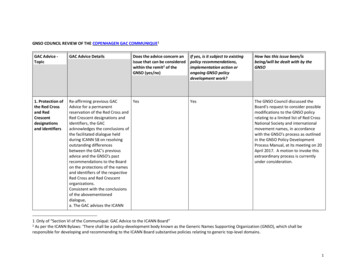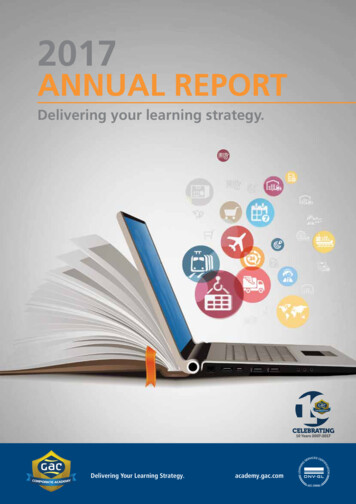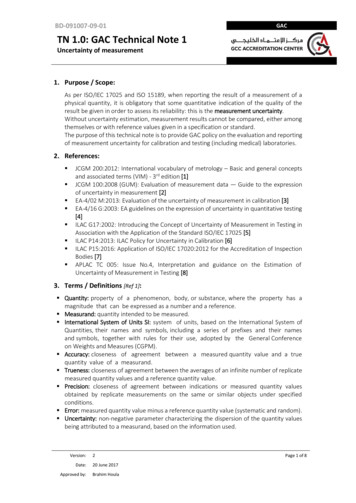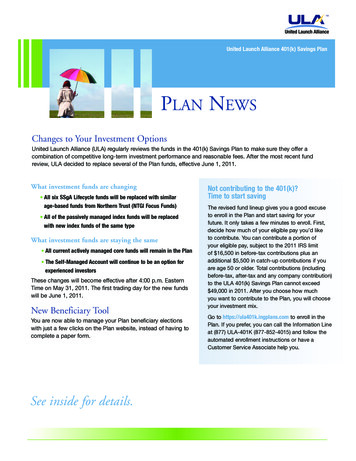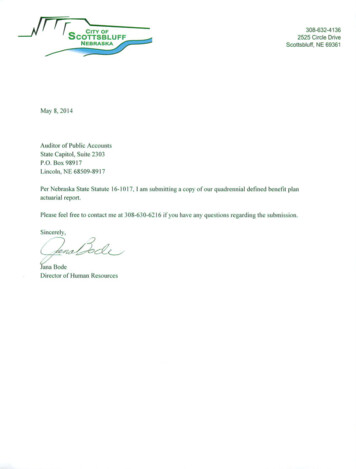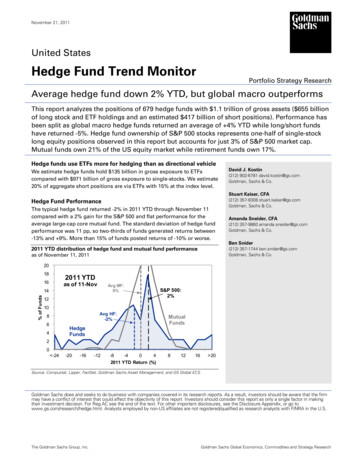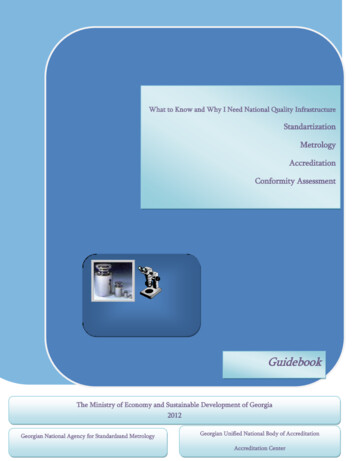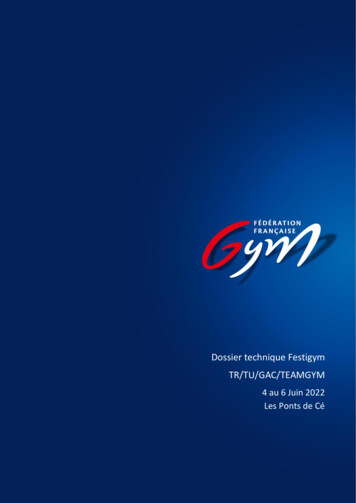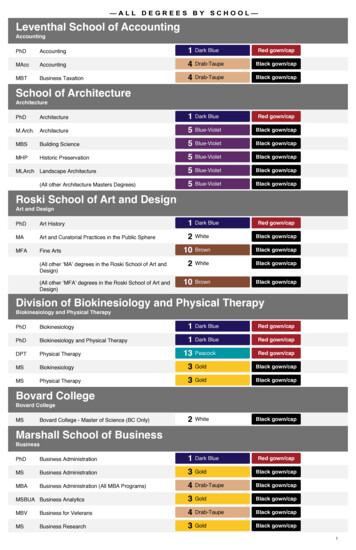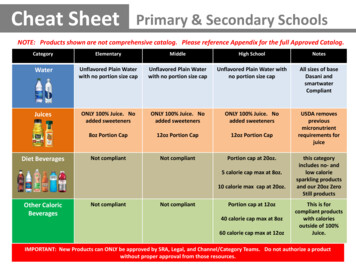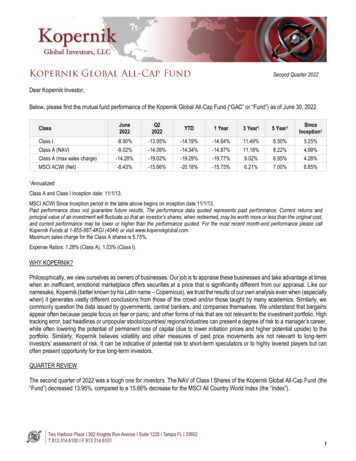
Transcription
Second Quarter 2022Dear Kopernik Investor,Below, please find the mutual fund performance of the Kopernik Global All-Cap Fund (“GAC” or “Fund”) as of June 30, 2022.ClassClass IClass A (NAV)Class A (max sales charge)MSCI ACWI (Net)June2022Q22022YTD1 Year3 Year15 edClass A and Class I inception date: 11/1/13.MSCI ACWI Since Inception period in the table above begins on inception date 11/1/13.Past performance does not guarantee future results. The performance data quoted represents past performance. Current returns andprincipal value of an investment will fluctuate so that an investor’s shares, when redeemed, may be worth more or less than the original cost,and current performance may be lower or higher than the performance quoted. For the most recent month-end performance please callKopernik Funds at 1-855-887-4KGI (4544) or visit www.kopernikglobal.com.Maximum sales charge for the Class A shares is 5.75%.Expense Ratios: 1.28% (Class A), 1.03% (Class I).WHY KOPERNIK?Philosophically, we view ourselves as owners of businesses. Our job is to appraise these businesses and take advantage at timeswhen an inefficient, emotional marketplace offers securities at a price that is significantly different from our appraisal. Like ournamesake, Kopernik (better known by his Latin name – Copernicus), we trust the results of our own analysis even when (especiallywhen) it generates vastly different conclusions from those of the crowd and/or those taught by many academics. Similarly, wecommonly question the data issued by governments, central bankers, and companies themselves. We understand that bargainsappear often because people focus on fear or panic, and other forms of risk that are not relevant to the investment portfolio. Hightracking error, bad headlines or unpopular stocks/countries/ regions/industries can present a degree of risk to a manager’s career,while often lowering the potential of permanent loss of capital (due to lower initiation prices and higher potential upside) to theportfolio. Similarly, Kopernik believes volatility and other measures of past price movements are not relevant to long-terminvestors’ assessment of risk. It can be indicative of potential risk to short-term speculators or to highly levered players but canoften present opportunity for true long-term investors.QUARTER REVIEWThe second quarter of 2022 was a tough one for investors. The NAV of Class I Shares of the Kopernik Global All-Cap Fund (the“Fund”) decreased 13.95%, compared to a 15.66% decrease for the MSCI All Country World Index (the “Index”).1
Reversing their positive contribution from the previous quarter, the materials sector was the largest detractor from Fund returns,detracting 7.3% from total Fund returns. Within materials, many of the Fund’s holdings were down significantly. The largest singledetractor was Newcrest Mining Ltd (“Newcrest”), a senior gold producer in Australia and one of the Fund’s largest positions.Newcrest was down 28%, a 1.4% detraction. Other primary detractors were a trio of Canadian gold companies with strongreserves: Equinox Gold Corp (“Equinox”), down 46.2%, Seabridge Gold (“Seabridge”), down 33.0%, and IAMGOLD Corp(“IAMGOLD”), down 53.7%. Equinox detracted 1.0%, while Seabridge detracted 0.7% and IAMGOLD detracted 0.6%. We addedto all three companies.We remain positive on the fundamentals for gold and other precious metals. As we have discussed before, the fundamentals formining companies are appealing without inflation, and additionally, it is highly likely that the central banks’ unprecedented moneyprinting over the past decade and a half will remain a strong positive for gold, even well into the current “tightening” phase.Currently, roughly 25% of the portfolio is invested in the materials sector, diversified across companies, geographies, andmanagement teams. We see significant upside to the risk-adjusted intrinsic value of the Fund’s mining stocks.Reversing many of their gains from Q1, energy stocks detracted from total Fund returns in the second quarter. As a whole, thesector detracted 2.4%. Uranium stocks made up the majority of this detraction. NAC Kazatomprom JSC (“Kazatomprom”), theworld’s largest uranium miner, and Cameco Corp, the second largest, were both down 18.7% and 27.8% respectively. Eachdetracted 0.5% from total Fund returns. NexGen Energy Ltd, which has a development project in the Athabasca region of Canada,was down 35.7%, a 0.4% detraction. Uranium remains an undervalued commodity, in our opinion, and uranium miners are tradingat a substantial discount to their risk-adjusted intrinsic value. As the global desire for clean power continues to grow, we believenuclear power will be an important component of that transition. To meet demand, which should increase in the future as morenuclear reactors are built, uranium miners will need to increase production significantly. Current prices are not incentivizing thisproduction. Elsewhere, in the financial sector, the Sprott Physical Uranium Trust (“Sprott Uranium”), a company that purchasesand holds physical uranium, was down 28.6%, a 0.7% detraction. We trimmed the energy sector heavily during the prior quarterand welcomed the opportunity to build the position back up at current, much lower prices. We recently added to Sprott Uraniumand Kazatomprom.In agriculture, two Indonesian palm oil companies reversed their gains from the previous quarter and detracted from total Fundreturns: Golden Agri-Resources Ltd (“Golden Agri”) was down 17.6% and detracted 0.4%, while First Resources Ltd was down20.6%, a 0.3% detraction. We added to Golden Agri. The price of palm oil has been very volatile thus far in 2022; in the firstquarter, palm oil rose 58%, reaching a multi-year high at the beginning of March, and subsequently fell steadily during the monthof May and June. With yields 7 times higher than soy oil, palm oil is one the most land efficient food oils. Further, as environmentalprotections have limited new plantings, palm oil supply is effectively fixed. We believe the ESG concerns about palm oil arebackward looking since many investors seem not to appreciate the significant improvements in ESG over the past decade. Thismisperception has created an opportunity and palm oil producers remain undervalued, in our opinion. Both Golden Agri and FirstResources are heavily discounted on an enterprise value/acre basis.Positive contributions to the Fund were made by a variety of companies. The Fund’s largest contributor was Centrais EletricasBrasileiras (“Eletrobras”), which was up 12.8% and contributed 0.3% to total Fund returns. Eletrobras is Brazil’s largest electricutility and has 90% of their generating capacity in hydroelectric power. WH Group Ltd (“WH Group”), the largest verticallyintegrated pork producer in China, was up 25.1%, a 0.2% contribution. Although most energy companies were detractors, therewere positive contributions from two companies, MEG Energy Corp (“MEG”), a Canadian oil sands producer, and Japan PetroleumExploration (“Japex,”), which engages in exploration and production of oil and natural gas in Japan, Canada, Iraq, and Indonesia.MEG was up 1.2%, while Japex was up 11.7%. There were also positive contributions from two shipping/transportationcompanies: Stolt-Nielsen Ltd (“Stolt-Nielsen”), one of the world’s largest providers of integrated transportation, storage, anddistribution solutions for specialty bulk-liquids, was up 14.6%, while Kamigumi Co Ltd (“Kamigumi”), the leading port transport2
company in Japan, was up 6.9%. MEG, Japex, Stolt-Nielsen, and Kamigumi each made a 0.1% contribution to total Fund returns.We trimmed Eletrobras, WH Group, and Kamigumi, added to Japex on a price dip mid-quarter, and eliminated our position inMEG Energy as prices appreciated early in the quarter.During the quarter, all Russian holdings, with the exception of RusHydro, performed negatively in Ruble terms, however allRussian securities performed positively in dollar terms as the Ruble appreciated 49% during the quarter. The contribution impactwas muted due to the 70% haircut we have applied to Russian securities. As a reminder, we remain unable to trade thesesecurities due to decisions by both the U.S. and Russian governments. The Moscow Stock Exchange re-opened at the end ofMarch, but trading remains limited to people and/or countries “friendly” to Russia. The government of Russia also passed a lawthat would require the de-listing of depository receipts (“DRs”) on foreign exchanges and the conversion of those DRs into localshares, although various Russian companies have been allowed to keep their DR programs abroad. Additionally, in early June,the U.S. published guidance stating that U.S. persons are prohibited from any acquisition of both new and existing debt and equitysecurities issued by Russian entities. U.S. persons are not required to sell or divest and can continue to hold previously acquiredRussian debt or equity securities.As we have commented elsewhere, many in the industry have priced the Russian securities at zero. We believe this approachwould not be fair to the existing Fund shareholders and are therefore recommending fair-value pricing of Russian securities to theFund’s administrator at a significant discount to the last trade (the aforementioned 70% haircut), adjusted for movements of theruble. We continue to actively monitor the events and any new or changing requirements.The Fund finished building multiple positions in the second quarter, many of which highlight the opportunities we are currentlyfinding in Asia. Four are Japanese companies: Icom Inc., which manufactures 2-way wireless communications for radio operatorsand trades at a negative enterprise value; Tachi-S Co Ltd, a car seat manufacturer with a diversified customer base that currentlytrades at 0.5 times price to book; Ryosan Co Ltd, a semiconductor distributor that trades at 9.5 times price to earnings and 0.5times price to book; and Toho Holdings Co Ltd, the fourth largest pharmaceutical distributor in that country, which trades at 0.7times price to book and 0.1 times enterprise value/sales. There were also two initiations in Chinese companies: Hi Sun TechnologyLtd, a Chinese payment processor with smaller divisions in security chips, smart electric meters, and security consulting (webelieve that the value of one subsidiary covers the value, effectively giving investors the rest for free), and Shanghai ElectricGroup Co Ltd, a Chinese company that is a global leader in manufacturing power and industrial equipment. Both are undervaluedon multiple metrics. The Fund also initiated positions in Hana Financial Group Inc, one of the largest financial groups in Korea,and Perpetua Resources Corp, the owners of a brownfield gold project in Idaho that is in the midst of the permitting process.The Fund eliminated positions in MEG Energy Corp, China Shenhua Energy Co Ltd., and Emlak Konut Gayrimenkul YatirimOrtakligi AS as prices appreciated. The Fund also eliminated a position in China Mobile Ltd. An executive order required us todivest of China Mobile prior to June 3, 2022. As we have previously discussed, this is a requirement that does not harm theChinese government but does hurt western shareholders that are forced to sell at low prices. It is unfortunate that we were forcedto sell our position.In closing, we continue to be focused on appraising businesses and mitigating risk through diversification across sectors andcountries. Bear markets and swift downdrafts are painful, but it is important to keep in mind that they create excellent buyingopportunities, which enhance future returns. Our investment process is centered on buying and holding companies trading atsignificant discounts to their risk-adjusted intrinsic value, and we view volatility as an opportunity to add and trim. You can counton us to employ our disciplined, fundamentals-based, long-term approach that has produced a proven track record throughout fullmarket cycles. As always, thank you for your support.3
Kind Regards,Kopernik Global Investors, LLCThe value of local Russian security holdings and Russian GDR/ADR holdings as of 6/30/2022 reflect fair value pricing.Important InformationMutual fund investing involves risk, including possible loss of principal. There can be no assurance that the Fund will achieve its statedobjectives. Equity funds are subject generally to market, market sector, market liquidity, issuer, and investment style risks, among otherfactors, to varying degrees, all of which are more fully described in the Fund’s prospectus. Investments in foreign securities may underperformand may be more volatile than comparable U.S. securities because of the risks involving foreign economies and markets, foreign politicalsystems, foreign regulatory standards, foreign currencies and taxes. Investments in foreign and emerging markets present additional risks,such as increased volatility and lower trading volume. For more information on the Kopernik Global All-Cap Fund, call our toll-free numberat 1-855-887-4KGI or email funds@kopernikglobal.com.The information presented herein is confidential and proprietary to Kopernik Global Investors, LLC. This material is not to be reproduced inwhole or in part or used for any purpose except as authorized by Kopernik Global Investors, LLC.This report may contain forward-looking statements within the meaning of the Private Securities Litigation Reform Act of 1995. Forwardlooking statements involve inherent risks and uncertainties, and we might not be able to achieve the predictions, forecasts, projections andother outcomes we may describe or imply. A number of important factors could cause results to differ materially from the plans, objectives,expectations, estimates and intentions we express in these forward-looking statements. We do not intend to update these forward-lookingstatements except as may be required by applicable laws.Forward-looking statements are not guarantees of future performance and are subject to risks, uncertainties and other factors, some of whichare beyond our control and are difficult to predict. As a result, actual results could differ materially from those expressed, implied or forecastedin the forward-looking statements.The top ten holdings of the Kopernik Global All-Cap Fund as of June 30, 2022, are as follows: 1. KT Corp (4.5%), 2. Newcrest Mining Ltd(4.2%), 3. Electricite de France SA (2.8%), 4. NAC Kazatomprom JSC (2.7%), 5. Turquoise Hill Resources Ltd (2.7%), 6. Centrais EletricasBrasileiras (2.4%), 7. LG Uplus Corp (2.3%), 8. Golden Agri-Resources (2.2%), 9. Sprott Physical Uranium Trust (2.1%), 10. Hyundai MotorCo (2.0%).Please consider all risks carefully before investing. An investment in a Kopernik Fund, or any other vehicle using the same strategy, is subjectto many risks including sudden changes in general market valuations and market liquidity. Investments in small and mid-capitalizationcompanies also tend to involve greater risk and portfolio price volatility than investments in larger capitalization stocks. Further, investing innon-U.S. markets, including emerging and frontier markets, involves certain additional risks, including potential currency fluctuations andcapital controls, restrictions on foreign investments, less governmental supervision and regulation, less liquidity, less disclosure, and thepotential for higher market volatility, share expropriation, confiscatory taxation, and social, economic and political instability. Further,investments in energy and other natural resources companies tend to be greatly impacted by developments in global commodities markets,which can be more volatile than equity markets.The Fund may purchase or sell options, which involve the payment or receipt of a premium by the investor and the corresponding right orobligation, as the case may be, to either purchase or sell the underlying security for a specific price at a certain time or during a certainperiod. Purchasing options involves the risk that the underlying instrument will not change price in the manner expected, so that the investorloses its premium. Selling options involves potentially greater risk because the investor is exposed to the extent of the actual price movementin the underlying security rather than only the premium payment received (which could result in a potentially unlimited loss). Over-the-counteroptions also involve counterparty solvency risk. For instance, a long put position would ordinarily realize a gain if, during the option period,the value of the underlying securities decreased below the exercise price sufficiently to cover the premium and transaction costs. However,if the price of the underlying instrument does not fall enough to offset the cost of purchasing the option, a put buyer would lose the premiumand related transaction costs.4
Countries worldwide have experienced outbreaks of infectious illnesses and may be subject to other public health threats, infectious illnesses,diseases or similar issues in the future. Any spread of an infectious illness, public health threat or similar issue could reduce consumerdemand or economic output, result in market closures, travel restrictions or quarantines, and generally have a significant impact on theeconomies of the affected country and other countries with which it does business, which in turn could adversely affect investments in thatcountry and other affected countries.Past performance herein should not be construed as an accurate indication of future returns.The MSCI All Country World Index (MSCI ACWI) is an index of over two thousand primarily large and mid-cap companies across 23developed and 24 emerging market countries as of June 30, 2022. The MSCI indices returns do not reflect any management fees, transactioncosts or expenses.Individuals cannot invest directly in an Index. Additionally, MSCI ACWI’s implied investments have differed from GAC’s strategy in a numberof material respects, including: 1) GAC’s investments in specific businesses, industries and countries have tended to be more concentratedthan shares comprising the MSCI ACWI; 2) GAC has tended to have more exposure to emerging markets and companies with smallermarket capitalizations than the MSCI ACWI, and; 3) consistent with its mandate, GAC has made minority allocations to other asset classesand derivative instruments not included in the MSCI ACWI. MSCI ACWI performance includes theoretical dividends distributed.The Global Industry Classification Standard (“GICS”) was developed by and is the exclusive property and a service mark of MSCI Inc.(“MSCI”) and Standard & Poor’s, a division of The McGraw-Hill Companies, Inc. (“S&P”) and is licensed for use by Kopernik Global Investors,LLC. Neither MSCI, S&P nor any third party involved in making or compiling the GICS or any GICS classifications makes any express orimplied warranties or representations with respect to such standard or classification (or the results to be obtained by the use thereof), andall such parties hereby expressly disclaim all warranties of originality, accuracy, completeness, merchantability and fitness for a particularpurpose with respect to any of such standard or classification. Without limiting any of the foregoing, in no event shall MSCI, S&P, any of theiraffiliates or any third party involved in making or compiling the GICS or any GICS classifications have any liability for any direct, indirect,special, punitive, consequential or any other damages (including lost profits) even if notified of the possibility of such damages.Investors should carefully consider the fund’s investment objectives, risks, charges, and expenses before investing. For this andother information, please call 1-855-887-4KGI (4544) or download a free prospectus at www.kopernikglobal.com. Read it carefullybefore investing.The Kopernik Global All-Cap Fund is distributed by SEI Investments Distribution Co., One Freedom Valley Drive, Oaks, PA, 19456, which isnot affiliated with Kopernik Global Investors, LLC.5
NexGen Energy Ltd, which has a development project in the Athabasca region of Canada, was down 35.7%, a 0.4% detraction. Uranium remains an undervalued commodity, in our opinion, and uranium miners are trading at a substantial discount to their risk-adjusted intrinsic value. As the global desire for clean power continues to grow, we believe
